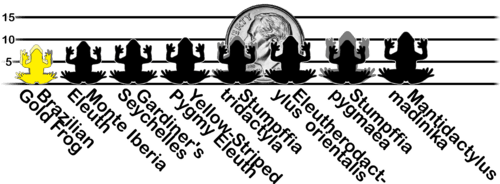Brazilian gold frog
| Brazilian gold frog | |
|---|---|
| Conservation status | |
| Scientific classification | |
| Kingdom: | Animalia |
| Phylum: | Chordata |
| Class: | Amphibia |
| Order: | Anura |
| Suborder: | Neobatrachia |
| Family: | Brachycephalidae |
| Genus: | Brachycephalus |
| Species: | B. didactylus |
| Binomial name | |
| Brachycephalus didactylus (Izecksohn, 1971)[1] | |
| Synonyms | |
| |
The Brazilian gold frog (Brachycephalus didactylus), also known as Izecksohn's toad, is the second smallest frog in the Southern Hemisphere (the smallest being Paedophryne amauensis of Papua New Guinea, described in 2012).
Adult Brazilian gold frogs measure to only 9.6–9.8 mm (0.38–0.39 in) in body length. Many have a beautiful golden color, for which they are named.
The smallest frogs of the Northern Hemisphere are the Cuban Eleutherodactylus iberia, which is similar in size, and Eleutherodactylus limbatus, of which fully mature adults as small as 8.5 mm have been found, though more typically 8.5 to 12 mm

A relative comparison of some of the world's smallest frogs.
See also
- Eleutherodactylus cosnipatae
References
- ↑ Izecksohn, E. (1971). "Novo genero e novo especie de Brachycephalidae do estado do Rio de Janeiro, Brasil (Amphibia: Anura)". Bol. Mus. Nac. Rio de Janeiro Zool. 280: 1–12.
- Telles & Potsch de Carvalho-e-Silva (2004). Brachycephalus didactylus. 2006. IUCN Red List of Threatened Species. IUCN 2006. www.iucnredlist.org. Retrieved on 12 May 2006. Database entry includes a range map and justification for why this species is of least concern
